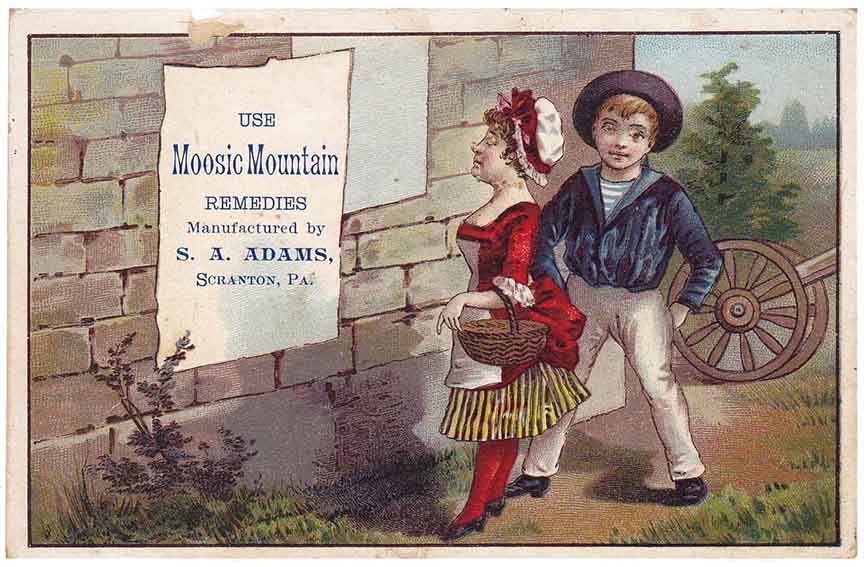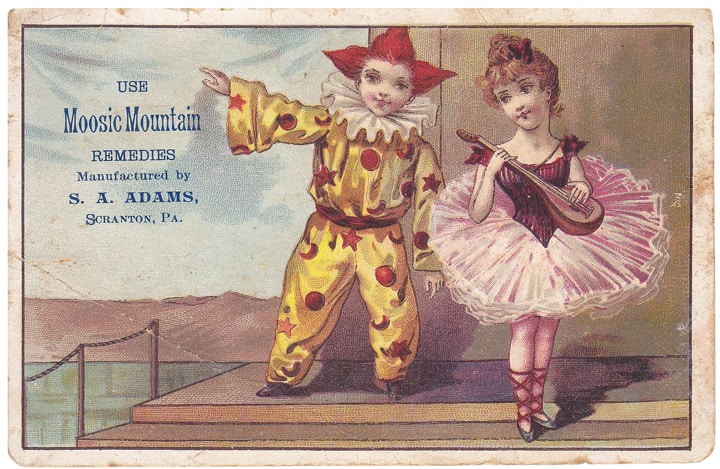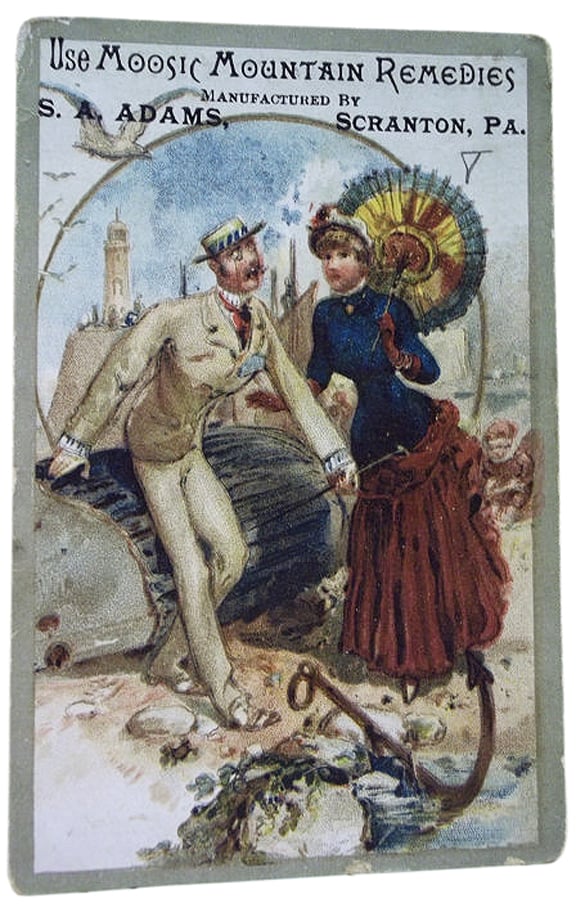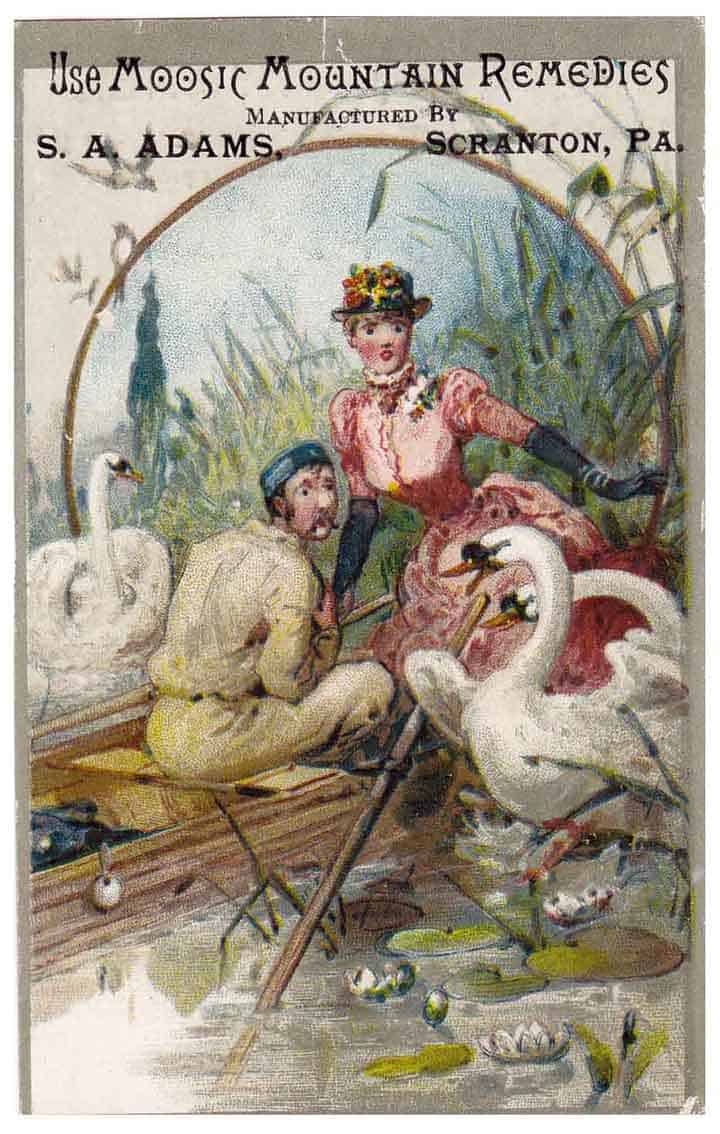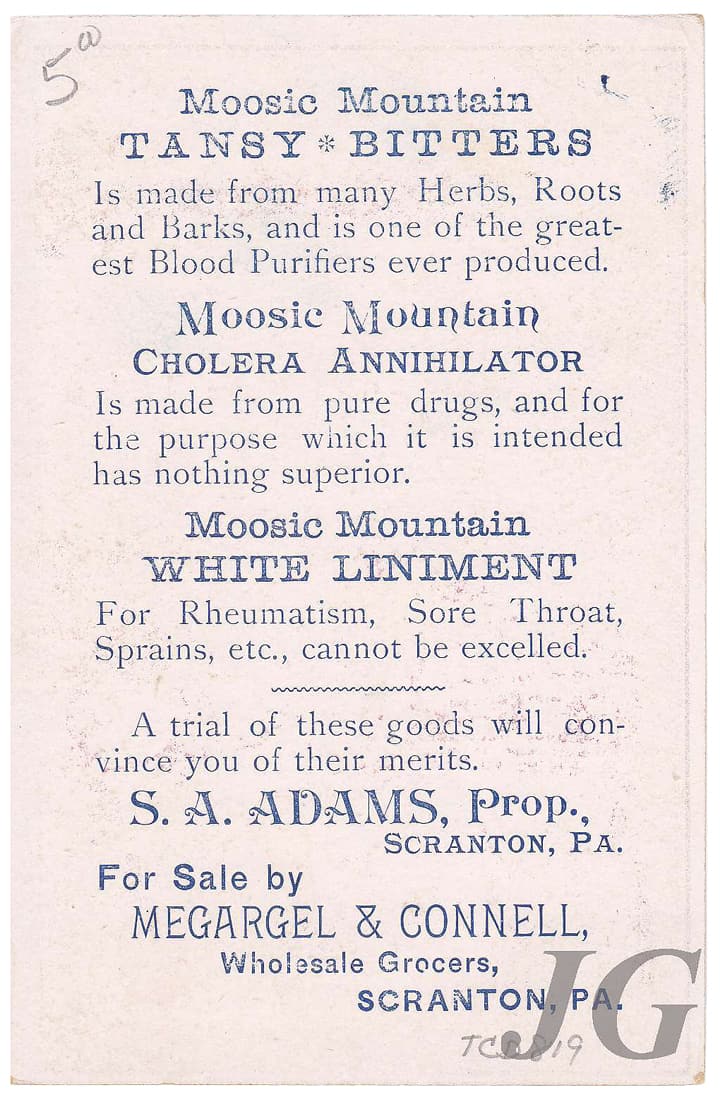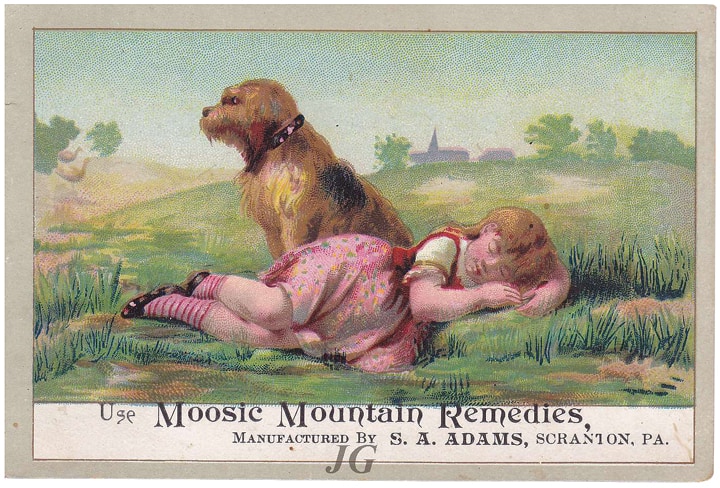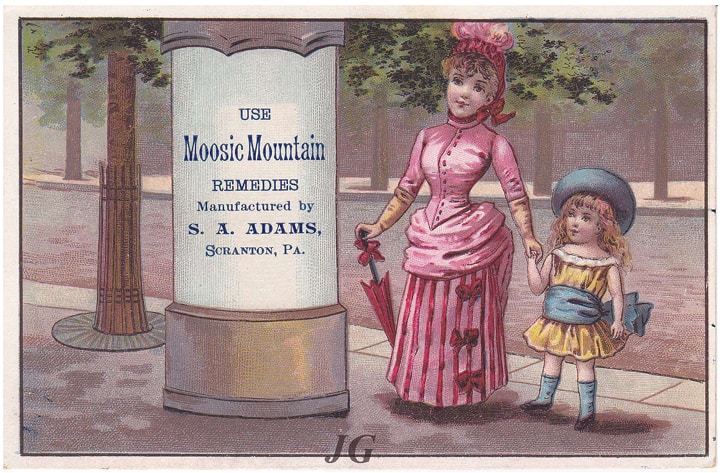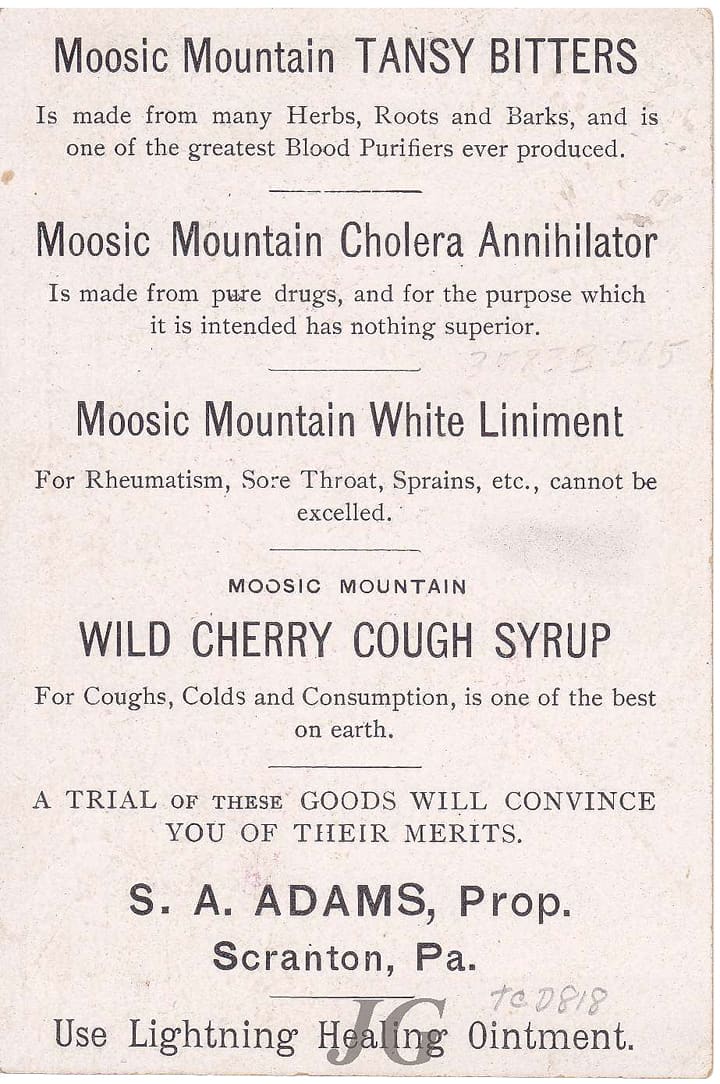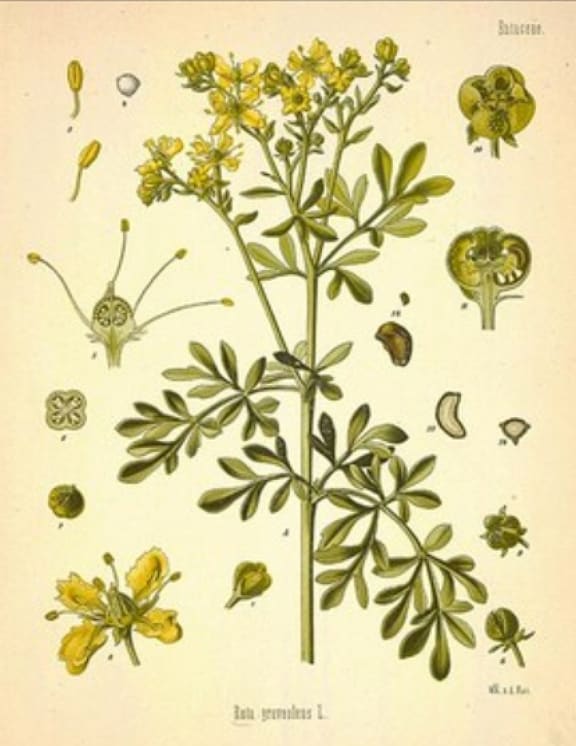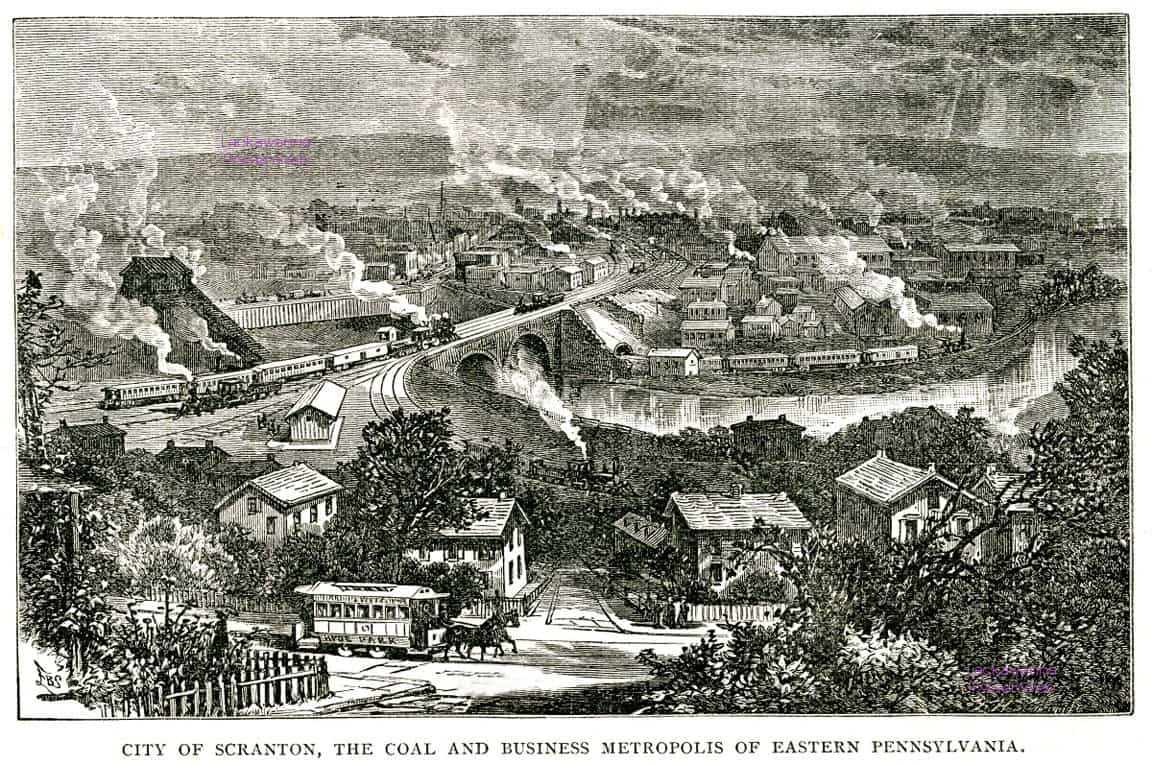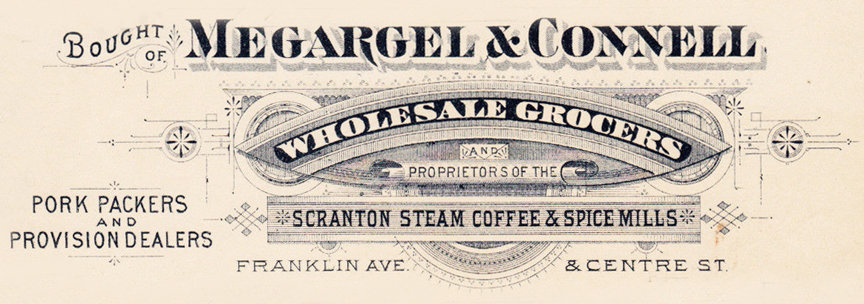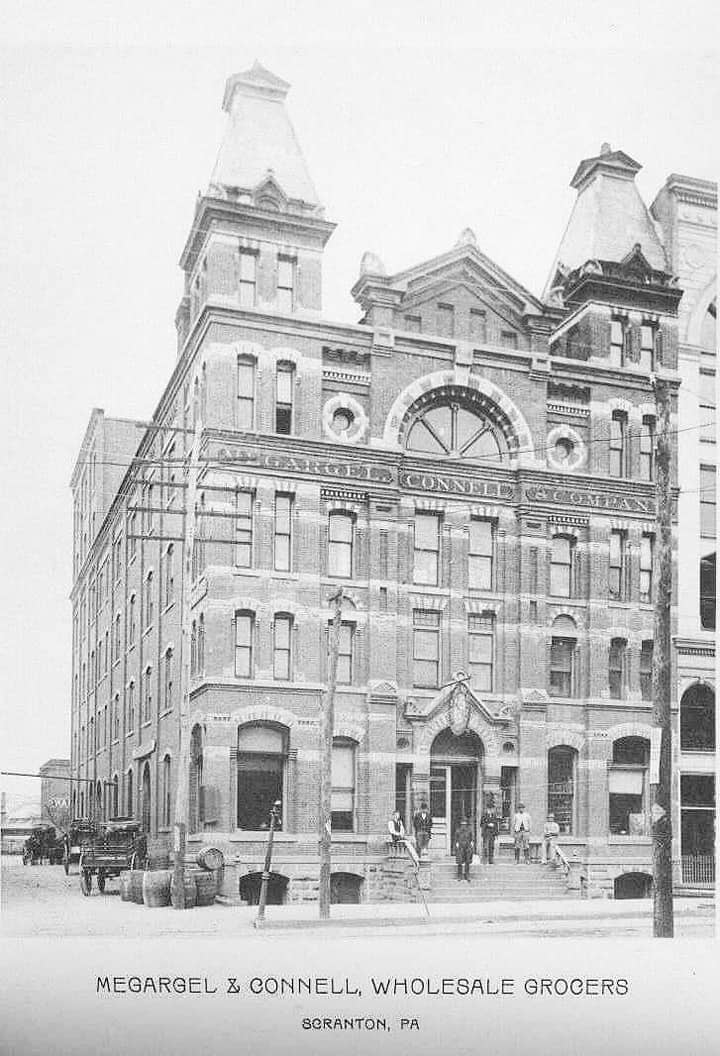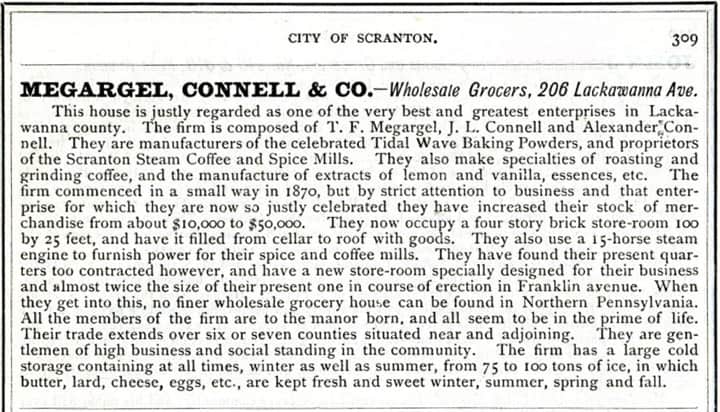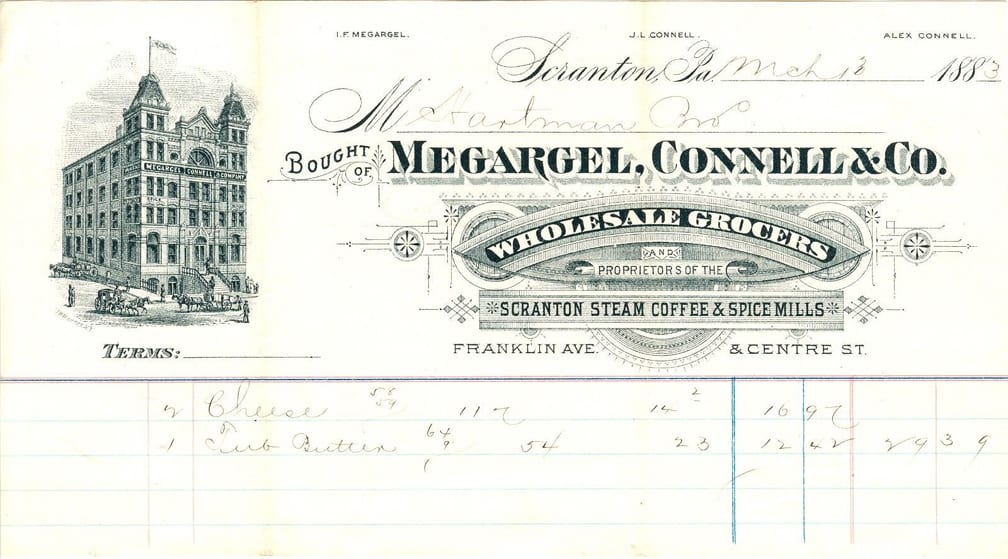Moosic Mountain Tansy Bitters
A TRIAL OF THESE GOODS WILL CONVINCE YOU OF THEIR MERITS
02 March 2014 (R•072019)
![]() Here is an unlisted bitters report based on trade card authority, Joe Gourd submitting the Moosic Mountain Tansy Bitters advertising pieces in this post. S. A. Adams was a proprietor and manufacturer of medicines in Scranton, Pennsylvania. This is a tough little card to track down. Along with Adams, we will look at the Tansy, Moosic Mountains, Scranton, and Megargel, Connell & Co., Wholesale Grocers.
Here is an unlisted bitters report based on trade card authority, Joe Gourd submitting the Moosic Mountain Tansy Bitters advertising pieces in this post. S. A. Adams was a proprietor and manufacturer of medicines in Scranton, Pennsylvania. This is a tough little card to track down. Along with Adams, we will look at the Tansy, Moosic Mountains, Scranton, and Megargel, Connell & Co., Wholesale Grocers.
S.A. Adams (Scranton, Pennsylvania) is a big mystery here. His name is on every card and he is either noted as the manufacturer or proprietor of:
Moosic Mountain Remedies
Moosic Mountain Cholera Annihilator
Moosic Mountain White Liniment
Moosic Mountain Wild Cherry Cough Syrup
Moosic Mountain Mountain Bitters
Lightning Healing Ointment
This could be Samuel A. Adams who was a merchant in this area. He was born around 1844. The Joe Gourd email:
Ferd,
Here are the trade cards for the unlisted “Moosic Mountain Tansy Bitters”. Moosic Mountain is located in Pennsylvania. The bitters were prepared in Scranton, Pa. We have previously used one of the cards in an earlier post. The card is the one with the girl and the dog. It was used in the “Children in Advertising posts. This unlisted bitters has been identified to Bill Ham.
Joe
Here is the new listing for Bitters Bottles Supplement 2 that will read:
Trade cards
M 128.3 MOOSIC MOUNTAIN TANSY BITTERS, Front: Use Moosic Mountain Remedies Manufactured by S. A. Adams, Scranton, Pa. Reverse: Moosic Mountain Tansy Bitters Is made from many Herbs, Roots ad Barks, and is one of the greatest Blood Purifiers ever produced.
The Moosic Mountains is a mountain range in northeastern Pennsylvania that stretches from Scranton to Mount Pleasant Township, a distance of roughly 32 miles. Most of the medicinal uses of Tansy have been discredited though Tansy is still a component of some medicines and is listed by the United States Pharmacopeia as a treatment for fevers, feverish colds, and jaundice
Tansy
Although most of its medicinal uses have been discredited, tansy is still a component of some medicines and is listed by the United States Pharmacopeia as a treatment for fevers, feverish colds, and jaundice.
Tansy (Tanacetum vulgare) is a perennial, herbaceous flowering plant of the aster family, native to temperate Europe and Asia. It has been introduced to other parts of the world and in some areas has become invasive. It is also known as Common Tansy, Bitter Buttons, Cow Bitter, Mugwort, or Golden Buttons.
Tansy has a long history of use. It was first recorded as being cultivated by the ancient Greeks for medicinal purposes. In the 8th century AD it was grown in the herb gardens of Charlemagne and by Benedictine monks of the Swiss monastery of Saint Gall. Tansy was used to treat intestinal worms, rheumatism, digestive problems, fevers, sores, and to “bring out” measles.
During the Middle Ages and later, high doses were used to induce abortions. Contradictorily, tansy was also used to help women conceive and to prevent miscarriages. In the 15th century, Christians began serving tansy with Lenten meals to commemorate the bitter herbs eaten by the Israelites. Tansy was thought to have the added Lenten benefits of controlling flatulence brought on by days of eating fish and pulses and of preventing the intestinal worms believed to be caused by eating fish during Lent.
Tansy was used as a face wash and was reported to lighten and purify the skin. In the 19th century, Irish folklore suggested that bathing in a solution of tansy and salts would cure joint pain. Although most of its medicinal uses have been discredited, tansy is still a component of some medicines and is listed by the United States Pharmacopeia as a treatment for fevers, feverish colds, and jaundice.
Scranton, Pennsylvania
“The Electric City”
Though anthracite coal was being mined in Carbondale to the north and Wilkes-Barre to the south, the industries that precipitated the city’s growth were iron and steel. In 1840, brothers Selden T. and George W. Scranton founded what would become the Lackawanna Steel Company.
On October 8, 1845, the Montour Iron Works in Danville, Pennsylvania, produced the first iron T-rails made in America, offering the first domestic competition to British exports. The Scrantons’ firm followed suit two years later, making rails for the Erie Railroad in New York state, and soon became a major producer.
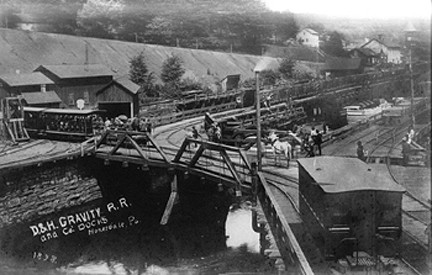
The Delaware and Hudson (D&H) Gravity Railroad was suggested by engineer Benjamin Wright, engineer of the company, as a more practical means of hauling coal over the Moosic Mountains than sleds and wagons used previously. It was on the tracks of this railroad that the first commercial locomotive – the Stourbridge Lion – turned a wheel by steam in America. – Wayne County Historical Society
In 1851, the Scrantons founded the Delaware, Lackawanna and Western Railroad (DL&W) to transport iron and coal products from the Lackawanna valley. The Pennsylvania Coal Company built a gravity railroad here for the same purpose. In 1856, the Borough of Scranton was officially incorporated. The Delaware and Hudson (D&H) Canal Company, which had its own gravity railroad from Carbondale to Honesdale, built a steam railroad that entered Scranton in 1863. This traveled over the Moosic Mountains which is a mountain range in Jefferson Township, Pennsylvania. It is the highest point in the Pocono Plateau, ranking 27th highest in Pennsylvania.
Scranton was incorporated as a city of 35,000 in 1866 in Luzerne County when the surrounding boroughs of Hyde Park (now part of the city’s West Side) and Providence (now part of North Scranton) were merged with Scranton. Twelve years later, the city became the county seat of the newly formed Lackawanna County.
The nation’s first successful, continuously operating electrified streetcar (trolley) system was established in the city in 1886, giving it the nickname “The Electric City”. The Lackawanna and Wyoming Valley Railroad – commonly known as the Laurel Line – connected Scranton with neighboring Wilkes-Barre; similar services operated from the nearby towns of Dunmore and Pittston. In 1896, the city’s various streetcar companies were consolidated into the Scranton Railway Company, which ran trolleys until 1954.
By 1890, three other railroads had built lines to tap into the rich supply of coal in and around the city, including the Erie Railroad, the Central Railroad of New Jersey and finally the New York, Ontario and Western Railway (NYO&W). Underneath the city, a network of coal veins was mined by workers who were given jobs by the wealthy coal barons with low pay, long hours and unsafe working conditions. Children as young as 8 or 9 worked 14-hour days separating slate from coal in the breakers. [Wikipedia]
Megargel, Connell & Co. – Wholesale Grocer
Isaac F. Megargel, James L. Connell, Alexander Connell, William Connell
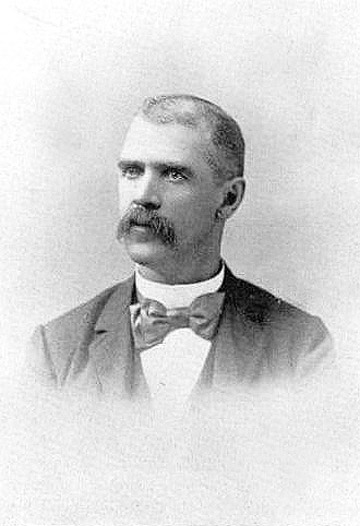
Isaac F. Megargel, born in Sterling PA 1841. Partner in grocer firm of Megargel & Connell – The City of Scranton and Vicinity and Their Resources, 1894
In 1858, when seventeen years of age, Isaac F. Megargel engaged in the lumber business near Elmhurst, Lackawanna county, Pennsylvania. He was the proprietor of a store there and also a mill for the manufacture of lumber. In 1862, he returned to Sterling, where he became interested in the mercantile business, but three years later disposed of this and located in Scranton, where he conducted a retail grocery business on Lackawanna avenue, near Franklin, but in the spring of 1868 removed to New York City where he was similarly engaged in Grand Street until the fall of 1869. On his return to Scranton, he opened a retail establishment on the corner of Washington and Lackawanna avenues, but the following year engaged in the wholesale business in Lackawanna above Franklin avenue, as a member of the firm of A. G. Gilmore & Company, consisting of A. G. Gilmore, James and William Connell and himself.
James L. Connell was born in Crystal Ridge, Pennsylvania in April 17, 1856 and died in Scranton, Pennsylvania on Match 20, 1919. Coming to Scranton when sixteen years of age, he began his business career in the wholesale establishment of A. G. Gilmore, subsequently associated with F. P. Price in retail grocery dealings under the firm name of Price & Connell. This partnership continued for two years and after his withdrawal in 1887, Mr. Connell formed a partnership with Isaac. F. Megargel and journeying to Des Moines, Iowa, they established a tea, coffee and spruce business. The following year they returned to Scranton, admitted Alexander Connell to the firm, changed the title to Megargel, Connell & Company, and engaged in wholesale grocery dealing until 1882, when upon the death of Alexander Connell, his interest was purchased by his partners and operations continued as Megargel & Connell. About 1899, Mr. Connell purchased his partner’s interest and admitted William Connell to the firm, which became J. L. Connell & Company. In 1902 their place of business was destroyed by fire and the affairs of the company were closed.
MEGARGEL & CONNELL
Wholesale Grocers and Manufacturers of Coffees and Spices, Franklin Avenue and Center Street
This important enterprise was originally established in 1870, the present firm, composed of Messrs. Isaac F. Megargel and James L. Connell having succeeded to the business in 1879. Year by year this house has increased its operations and augmented its capital and connections until its annual trade now reaches upwards of a million dollars and its stock is the heaviest in Northeastern Pennsylvania. The premises occupied by the firm are centrally located and possess unusual advantages for a business of this character.
They are contiguous to the railway depots, and comprise a handsome six-story and basement building, 50 x 132 feet in dimensions, with a fifty-foot wing in the rear and an adjoining “L”, 17 x 25 feet, the latter containing the coffee and spice mill department of the business. The main warerooms are conveniently arranged and equipped with every appliance necessary for the economical and successful prosecution of the business including Coffee Roasters, Spice Mills, Elevators, Steam Engine, etc. About twenty assistants, clerks, salesmen, porters and others are employed and in every respect the affairs of this great grocery establishment are directed by a combination of enterprise and integrity, which, while it acquires for itself the just profits its capital and industry merit, reflects credit upon the entire trade of our city, and conduces to the general welfare in no ordinary degree.
Devoted for so many years to the wholesale and jobbing trade, it has during its long and honorable career, watched the advancement of the interests of its customers, informing them so soon as possible of the complexion and character of every fluctuation in the market, by personal letters, thereby extending to retail merchants the full benefit of its experience and extensive connections, affording such merchants an opportunity to seize the legitimate advantages of the trade. In view of this and for every other reason that may characterize the best and largest grocery house, that of Messrs. Megargel & Connell may justly lay claim to be classed among the most enterprising and prominent of its kind in the State. Concerning the character and extent of the stock handled it may said that it is the best in the market and sufficient to supply the demands of an almost unlimited trade.
The firm’s brands of Coffees, Spices, Flavoring Extracts and other specialties of their own manufacture are of the highest quality and are in wide demand by the trade and consumers. A well equipped laboratory in charge of experienced assistants, is one of the facilities of the establishment, and among the prime specialties of the firm is Jadwin’s Tar Syrup, an unsurpassed article, which is sold in almost all sections of the country. Another leading specialty is Simon Pure Baking Powder. They are sole agents in this market for “Mother Hubbard” Flour, which is a high grade patent flour made at Stillwater, Minn., and through the efforts of the firm it has come to be the standard family flour of this section. In all lines of goods this house is headquarters and bottom prices are invariably maintained. The trade of the house is confined chiefly to this section of the State and is annually increasing in volume. The house is second to none of its competitors and the commanding position it occupies in the trade enables it to accord buyers all the advantages that result from a clever combination of industry, experience, skill and capital.

